|

|
|
| Ask the Experts | |||||||
|
|||||||
|
February 19, 2007 - Updated July 4, 2007 - Originally Posted Cleaning "no-clean" fluxWhen cleaning NO-CLEAN flux with Isopropyl alcohol, it leaves a white residue and sometimes it appears to be conductive if bridging leads. Do you know of any papers that would describe this issue or advice to eliminate this issue? Chris Halloran |
|||||||
| Expert Panel Responses | |||||||
|
We have published on cleaning a No Clean (it is a Circuits Assembly Article). It doesn't work well with just IPA and the white residue is a combination of solvent, flux and absorbed moisture. The thicker the solder paste the more cleaning energy is required. Please contact me (765-457-8095) and we can discuss our cleaning techniques used to clean a no clean.
President/Senior Technical Consultant Foresite Mr. Munson, President and Founder of Foresite, has extensive electronics industry experience applying Ion Chromatography analytical techniques to a wide spectrum of manufacturing applications.
There are a number of reasons for white residues from cleaning with IPA. Let me list just a few, and see if any of these hit a nerve: Purity. There are many grades and purity levels of IPA. The cheapest and most common grade is 30% water, and that is most common in stencil cleaning applications. It also is called "rubbing alcohol." A much better choice is to get a high-purity great of IPA, 99.9%+ water-free. It's a little more expensive, but works much better. Storage. Alcohol is "hygroscopic" which means it attracts contamination (including humidity) out of the air. If the alcohol has been sitting around a while, or stored improperly, it can actually dilute itself with water out of the air, as well as dust and other contamination. "Menda bottles" and squirt bottles of solvent are the typical culprits here. Alcohol should always be stored in sealed containers, out of bright sunlight, in cool, dry conditions. In most areas, alcohol also should be stored in flammable liquid storage cabinets for maximum safety. A better choice overall would be to upgrade out of IPA into a non-alcoholic solvent, such as a fast-drying, nonflammable HFC solvent from DuPont or a planet-friendly, people-safe siloxane solvent from Dow-Corning. Process. Many technicians use alcohol with a brush, to scrub the residues and loosen them from the PCB. The problem is that this process makes it very difficult, if not impossible, to rinse the contamination off the board. You can tell if some contamination remains simply by touching the board: if it's sticky, it's not clean. All proper cleaning processes require four steps: wet, scrub, rinse, and dry. Consider how you wash dishes at home, or give the baby a bath, or even wash the car in the driveway. There's always the same four steps: (a) Spray water on the car to wet the surface and begin to loosen the grime. (b) Take a soapy sponge and scrub away. (c) Take the hose and rinse the soap and the contamination off the vehicle. Lastly, (d) you dry the car. If you skip any of these steps, the car doesn't get clean. Well, circuit boards are the same way. If somebody is using the "dip-and-brush" method, they're wetting the residues and loosening them, but they can't rinse! If you can't rinse, you can't clean. That's why many companies use aerosol cleaners to flush and rinse after the scrubbing step. Quality aerosols are available from Chemtronics, Miller-Stephenson, Micro Care and TechSpray, as well as smaller companies. In addition, Micro Care Corp. sells a convenient tool, the Trigger Grip system, that connects to aerosol cans and makes implementing the four cleaning steps fast and easy. Google "Trigger Grip" or "Microcare.com" to learn more. Other Possible Causes. There are many other possible causes of conductive white residues. These can include improperly cured FR-4 substrates; solvent incompatibility with the no-clean flux, a non-standard manufacturing step that has slipped into the process, and more. In truth, while I have seen these, they are fairly rare. My recommendation would be to move to a stronger, non-alcohol-based cleaner such as VeriClean™ from Micro Care, and use a better cleaning system, like the Trigger Grip, to eliminate these residue issues completely. For more details, check out the following technical papers: This paper explains some of the new nonflammable cleaners from DuPont This paper presents a "check list" of characteristics to consider when selecting a new solvent. Please call if you have other questions.
Vice President Micro Care Mr. Jones is an electronics cleaning and stencil printing specialist. Averaging over one hundred days a year on the road, Mike visits SMT production sites and circuit board repair facilities in every corner of the globe, helping engineers and technicians work through the complex trade-offs today's demanding electronics require.
|
|||||||
| Submit A Comment | |||||||
|
Comments are reviewed prior to posting. You must include your full name to have your comments posted. We will not post your email address. |
|
Free Newsletter Subscription
Circuitnet is built for professionals who bear the responsibility of looking ahead, imagining the future, and preparing for it. Insert Your Email Address |
|

|




